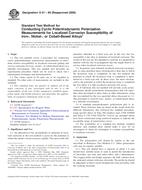We need your consent to use the individual data so that you can see information about your interests, among other things. Click "OK" to give your consent.
ASTM G61-86(2009)
Standard Test Method for Conducting Cyclic Potentiodynamic Polarization Measurements for Localized Corrosion Susceptibility of Iron-, Nickel-, or Cobalt-Based Alloys
STANDARD published on 1.5.2009
The information about the standard:
Designation standards: ASTM G61-86(2009)
Note: WITHDRAWN
Publication date standards: 1.5.2009
SKU: NS-57757
The number of pages: 5
Approximate weight : 15 g (0.03 lbs)
Country: American technical standard
Category: Technical standards ASTM
Annotation of standard text ASTM G61-86(2009) :
Keywords:
Cobalt alloys, Crevice corrosion, Cyclic corrosion testing, Cyclic potentiodynamic polarization measurement, Nickel-iron alloy, Polarization resistance, Potentiodynamic anodic polarization measurements, Stainless steel (corrosion testing), ICS Number Code 77.060 (Corrosion of metals)
Additional information
| Significance and Use | ||||||||
|
An indication of the susceptibility to initiation of localized corrosion in this test method is given by the potential at which the anodic current increases rapidly. The more noble this potential, obtained at a fixed scan rate in this test, the less susceptible is the alloy to initiation of localized corrosion. The results of this test are not intended to correlate in a quantitative manner with the rate of propagation that one might observe in service when localized corrosion occurs. In general, once initiated, localized corrosion can propagate at some potential more electropositive than that at which the hysteresis loop is completed. In this test method, the potential at which the hysteresis loop is completed is determined at a fixed scan rate. In these cases, the more electropositive the potential at which the hysteresis loop is completed the less likely it is that localized corrosion will occur. If followed, this test method will provide cyclic potentiodynamic anodic polarization measurements that will reproduce data developed at other times in other laboratories using this test method for the two specified alloys discussed in 3.4. The procedure is used for iron-, nickel-, or cobalt-based alloys in a chloride environment. A standard potentiodynamic polarization plot is included. These reference data are based on the results from five different laboratories that followed the standard procedure, using specific alloys of Type 304 stainless steel, UNS S30400 and Alloy C-276, UNS N10276. Curves are included which have been constructed using statistical analysis to indicate the acceptable range of polarization curves. The availability of a standard test method, standard material, and standard plots should make it easy for an investigator to check his techniques to evaluate susceptibility to localized corrosion. |
||||||||
| 1. Scope | ||||||||
|
1.1 This test method covers a procedure for conducting cyclic potentiodynamic polarization measurements to determine relative susceptibility to localized corrosion (pitting and crevice corrosion) for iron-, nickel-, or cobalt-based alloys in a chloride environment. This test method also describes an experimental procedure which can be used to check one's experimental technique and instrumentation. 1.2 The values stated in SI units are to be regarded as standard. No other units of measurement are included in this standard. 1.3 This standard does not purport to address all of the safety concerns, if any, associated with its use. It is the responsibility of the user of this standard to establish appropriate safety and health practices and determine the applicability of regulatory limitations prior to use. |
||||||||
| 2. Referenced Documents | ||||||||
|
We recommend:
Technical standards updating
Do you want to make sure you use only the valid technical standards?
We can offer you a solution which will provide you a monthly overview concerning the updating of standards which you use.
Would you like to know more? Look at this page.




 Cookies
Cookies
